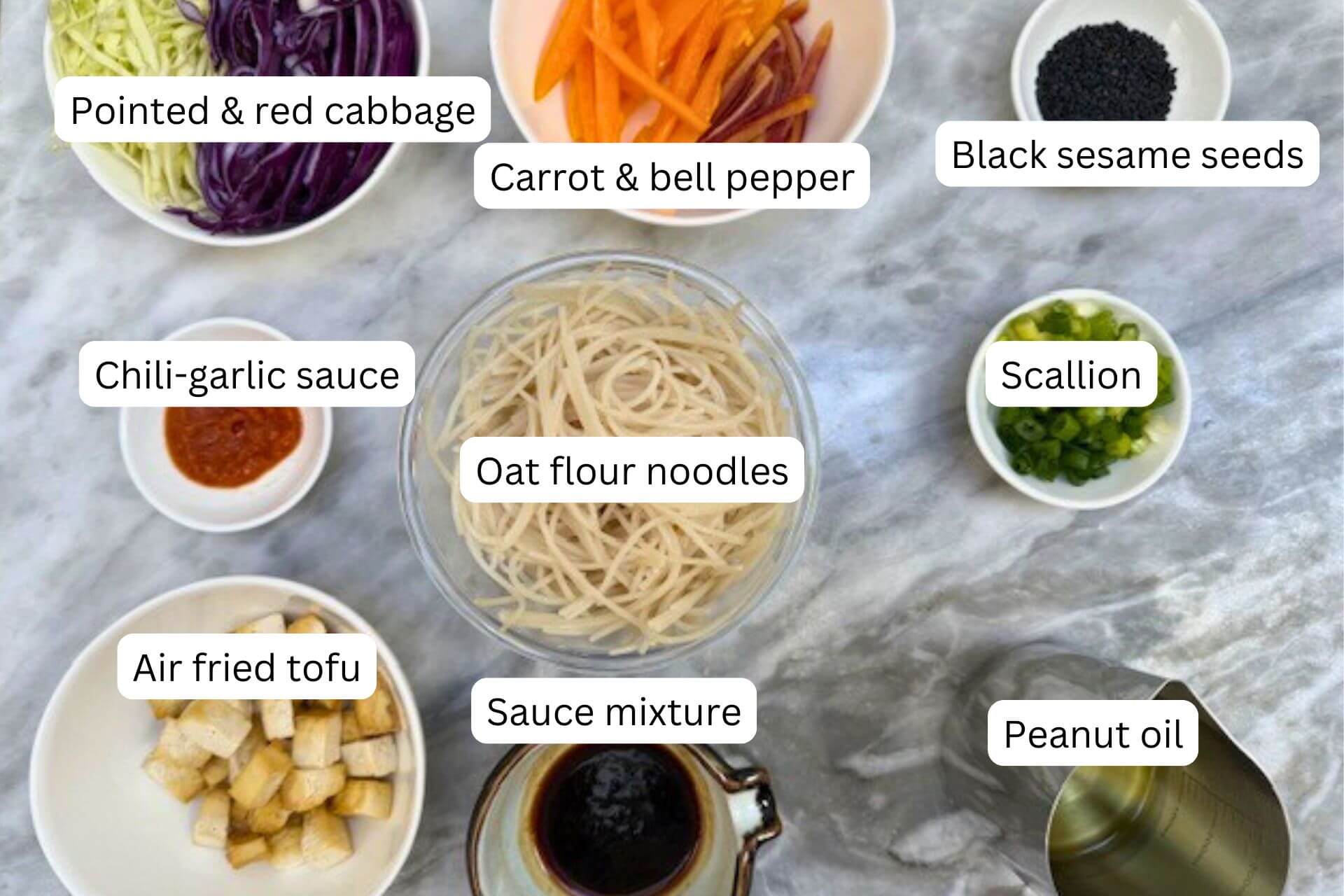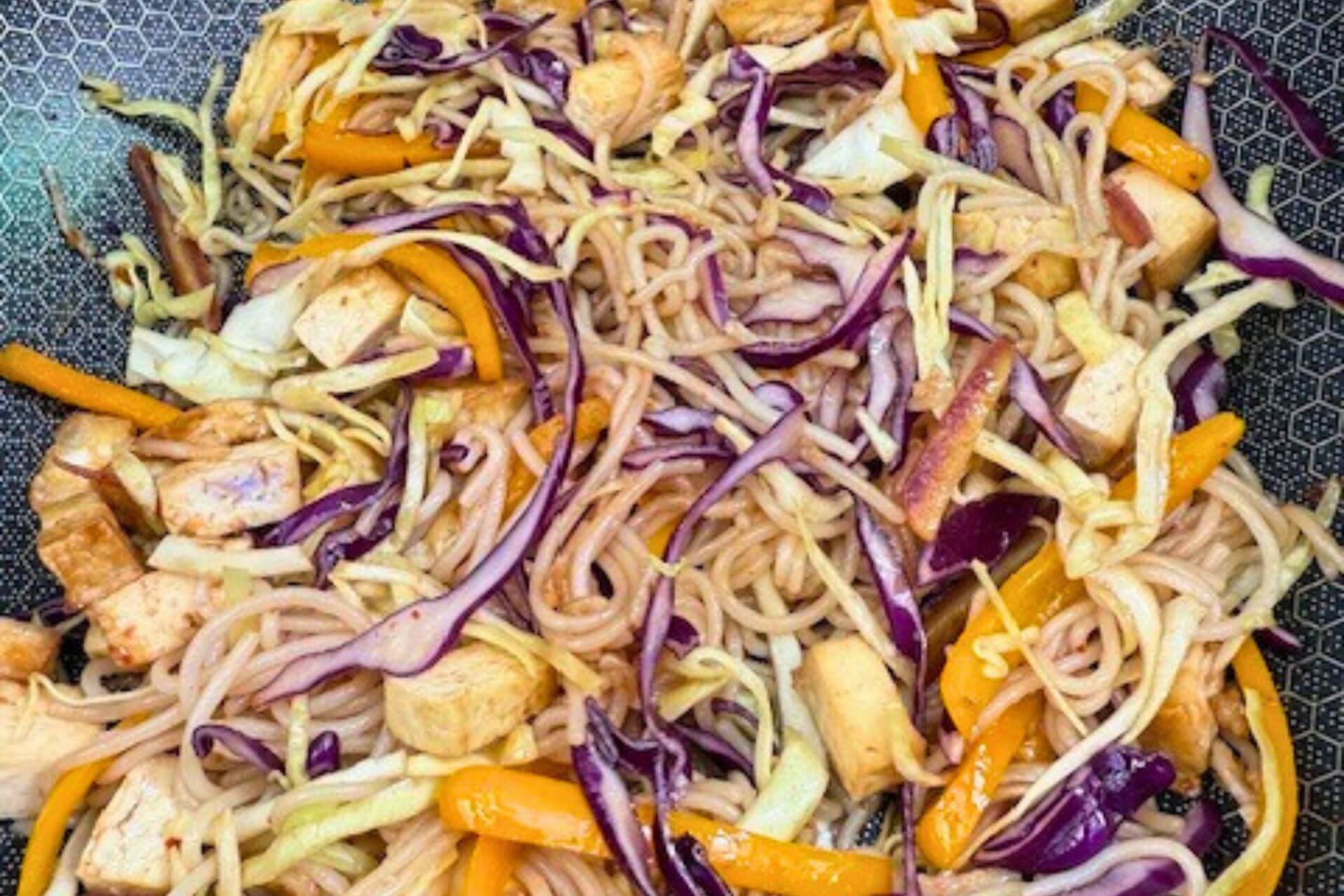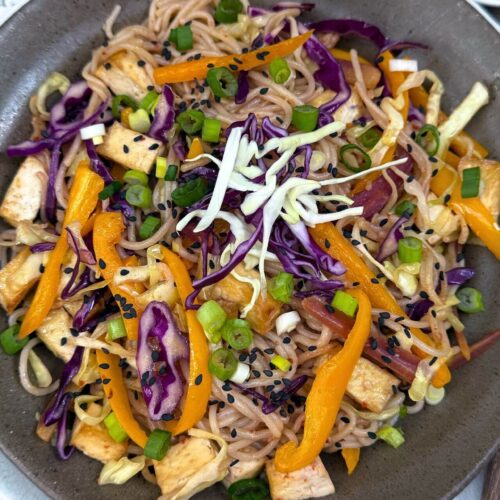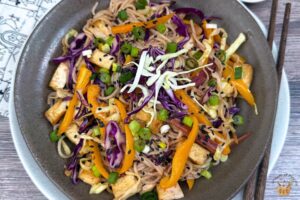Vegetable Chow Mein Recipe features a delightful stir-fry of noodles with veggies and tofu. The carrots, peppers, and air-fried tofu are stir-fried to crunchy perfection with the al dente-cooked noodles. The noodles are coated with a sauce mixture of light and dark soy and hoisin sauces, giving them a rich, umami flavor. The red and green shredded cabbage adds a burst of freshness and color, while the tofu adds a satisfying protein-packed bite. This wholesome vegetarian dish can be enjoyed as a light meal garnished with toasted black sesame seeds and scallions, yielding a combination of taste, texture, and nutrition!
A lot has been written about chow mein, and it is one of those foods that has gone global. Growing up in India, chow mein was a popular, standard, ‘go-to’ dish that was available at any Chinese restaurant. When we visited Shanghai, I ordered Vegetable Chow Mein at a food court in a popular mall. I remember the chef giving me a somewhat bemused look by saying, “You’re asking for fried noodles. But what type of fried noodles?” That was the beginning of my exposure to the myriad varieties in which chow mein is made.
What is chow mein?
‘Miàn’ (which is sometimes transliterated to ‘mein’) refers to wheat-based noodles, whereas ‘fěn’ refers to rice-based noodles. The phrase ‘chow’ or ‘chao’ just means fried or stir-fried. But as the Chinese diaspora spread, so did the context of these noodles. Would it surprise you to find that there are over a thousand types of noodles? Any noodle that is made of wheat and fried could be called ‘chow mein’ or ‘fried wheat noodles,’ while ‘chow fun’ means ‘fried rice noodles.’ If you visit Southeast Asia, where there is a prevalence of people who speak Hokkien, you may hear ‘miàn’ referred to as ‘mee’ ~ think Mee Goreng and fěn referenced to as ‘hún’ or ‘sua’ as in hô-hún.
Global variations:
In India, you can find fried noodles served with and without gravy, depending on the restaurant. It is served with seasonal vegetables or paneer (Indian cottage cheese). When I visited the Caribbean, I sampled the ‘tjauwmin’. There are also differences between the East and West Coast here in the U.S. On the East Coast, when I ordered Vegetable Chow Mein, I was served a crispy noodle surrounded by gravy, whereas on the West Coast, the recipe called for stir-fried veggies with soy. The bottom line is that just as the Chinese diaspora is global, so are the innumerable variations of these fried wheat noodles.
This brings me to my own version. My Vegetable Chow Mein Recipe is one that was inspired by my visits to Hong Kong, which makes this version more Cantonese in its profile. The reason I’m fond of this recipe is that it represents the best of Chinese cuisine. It uses sauces, but it highlights the essential quality of Chinese food: the freshness and unique flavor that each ingredient brings to a carefully balanced and harmonious meal. I have used oat flour noodles to give it a healthy twist.
Types of soy sauce:
Given the global varieties of ‘chow mein’, let me talk a little bit about the types of sauces that are generally used. The first and most obvious is the ubiquitous soy sauce. Soy sauce is the liquified form of fermented and brined soybeans that have been processed and strained. There are at least seven types of soy commonly available today, although most soy-using nations have their own versions.
- Light: Generally, light soy sauce is a thin sauce, and although it generally contains less sodium in comparison to the darker variety, it has a saltier flavor. You could even use the low-sodium soy sauce.
- Dark: Dark soy sauce, while being less salty, has more sodium. The saltiness is, to a large degree, subsumed by the greater amount of sugar that is added. This makes the dark soy sauce thicker and sweeter while packing a heavier soybean flavor.
- Dark and sweet soy:
- Kecap Manis: You will find a variant of the dark soy which is even sweeter. It is not exactly soy sauce but is more a sauce that has a soy base but is heavily flavored by spices such as anise, pepper, clove, palm sugar, and cinnamon, resulting in a molasses-like sticky and thick consistency.
- Hoisin: Another version of fermented soybeans, but hoisin is usually made from garlic, sesame oil, chilis, vinegar, and some form of sugar or other sweeteners. Like the kecap manis, it also has a molasses-type consistency.
- Tamari is often misunderstood as the standard gluten-free alternative to traditional soy, which has wheat in it. It is a byproduct of producing miso sauce and while it can have no wheat, there is no guarantee of that.
- Double Fermented: This is soy sauce that is fermented a second time alongside wheat, and soy. This results in a stronger soy sauce, and some would say it has more ‘umami’ in it.
- White soy: White soy isn’t white. It’s more of golden or rosé. This is the result of soy being produced with a higher percentage of wheat as compared to soy.
In my Vegetable Chow Mein recipe, I use both dark and light soy and a dash of hoisin sauce to yield umami that balances salt and sweetness. I find that the hoisin perks the dish up and reminds me of the noodles I had in Hong Kong.
Frequently Asked Questions:
- What is the difference between chow mein and lo mein?
Chow Mein uses thin and flat noodles that are stir-fried with a slightly crispy texture. Lo Mein uses a more rounded noodle that is cooked in the sauce.
2. What other veggies can I add to this Vegetable Chow Mein recipe?
You can also add shiitake, bamboo shoots, green beans, beansprouts, cauliflower, baby corn, water chestnuts, bok choy, and Chinese cabbage.
3. What type of noodles are generally used for this dish?
Fresh yellow noodles are commonly used; you could substitute them with ramen or egg noodles. I have used oat flour noodles as a healthier option.
This post may contain affiliate links. As an Amazon Associate, I earn from qualifying purchases at no extra cost to you.
If you’ve tried this recipe or have questions, I would love to hear from you. Please feel free to share (below) your thoughts, comments, or any questions that you might have. If you like my recipes, you could subscribe to my mailing list for the latest recipes that will be delivered to your inbox. From my pen to your table, Bon Appetit!

Ingredients:

- Veggies/tofu: carrot, bell pepper, red cabbage, pointed green cabbage, and air-fried tofu (or add shiitake, bamboo shoots, green beans, beansprouts, cauliflower, baby corn, water chestnuts, bok choy, and Chinese cabbage)
- Noodles: oat flour noodles (or use whole wheat, thin flat noodles, egg noodles)
- Aromatics: chili-garlic sauce, lemongrass
- Sauce mixture: dark and light soy sauce, hoisin sauce (or use oyster sauce)
- Oil: peanut oil and chili sesame oil
- Garnish: scallion, black sesame seed
Here are the step-by-step instructions on how to make this dish. For the measurements, please refer to the recipe card below.
How to make the Vegetable Chow Mein using my recipe:
- Heat a wok, add the peanut oil and the chili-garlic sauce ground with the lemongrass. Sauté for 1-2 minutes, and add the carrot and peppers. Stir-fry for 1 minute on high heat.

2. Add the cooked noodles, cabbage, air-fried tofu, and the prepared sauce mixture. Stir-fry for 1-2 minutes.

3. Turn off the heat. Plate the Vegetable Chow Mein garnished with scallion, toasted black sesame seeds, and some shredded cabbage.

- As you fry the veggies and noodles, keep stirring and scraping the bottom of the wok, and adjust the taste with soy sauce.
- To make it spicier, add more of the chili-garlic sauce.
- Cook the noodles to al dente so that they hold their shape when stir-fried on high heat. Overcooking the noodles will make them mushy.
- Add leafy vegetables or cabbage towards the end to preserve their crunch.
Serving suggestion:
I served the Vegetable Chow Mein on a plate garnished with black sesame seeds and scallions. It pairs well with a Green Onion Pancake or soup.
Storage:
Vegetable Chow Mein can be refrigerated for 2-3 days and frozen in airtight boxes for three months. While reheating, drizzle some peanut oil in a hot wok, and add the chow mein and some soy sauce at the end.
Other noodle dishes that you might like:
Vegetable Chow Mein Recipe
Equipment
- Wok
Ingredients
For the Vegetable Chow Mein:
- 1 tbsp peanut oil
- 1½ tsp chili-garlic sauce
- 2 lemongrass white, crushed
- ¼ cup carrot juilienne
- ¼ cup pepper julienne
- ½ cup firm tofu cubed
- ½ lb oat flour noodle
- ⅓ cup pointed green cabbage shredded
- ⅓ cup red cabbage shredded
- 1 tsp toasted black sesame seed optional for garnish
- 2 scallion chopped
For the sauce mixture:
- 1 tbsp dark soy sauce
- 1 tbsp light soy sauce
- 1½ tsp hoisin sauce
- ½ tsp chili sesame oil
Instructions
- Prepare the ingredients. Air fry the cubed tofu at 400 degrees F for 15 minutes on a foil-lined tray. Mix the ingredients for the sauce together in a bowl and keep aside. Cook the noodles al dente per manufacturer's instructions.
How to stir-fry the Vegetable Chow Mein:
- Heat a wok, add the peanut oil and the chili-garlic sauce ground with the lemongrass. Sauté for 1-2 minutes, and add the carrot and peppers. Stir-fry for 1 minute on high heat.
- Add the cooked noodles, cabbage, air-fried tofu, and the prepared sauce mixture. Stir-fry for 2-3 minutes.
- Turn off the heat. Plate the Vegetable Chow Mein garnished with scallion, toasted black sesame seeds, and some shredded cabbage.
Notes
- As you fry the veggies and noodles on high heat, keep stirring and scraping the bottom of the wok, and adjust the taste with soy sauce.
- I air-fried the tofu to add some texture to the noodles. This step is optional. Instead, cut the tofu into cubes and add them to the veggies without air frying, if you prefer.
- To make it spicier, add more of the chili-garlic sauce. (Lemongrass ground in the chili garlic sauce in a spice grinder is optional).
- Do not overcook the noodles as they will become mushy. Reduce the cooking time of the noodles by 1-2 minutes per the manufacturer's instructions to make them al dente.
Nutrition



























0 Comments